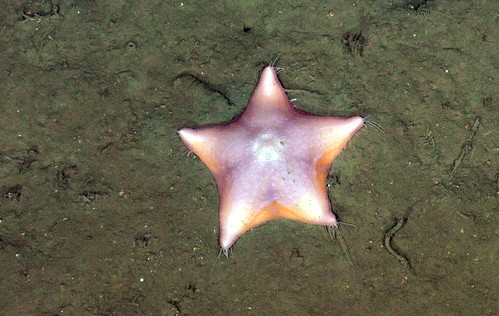 |
| From 2001. Hymenaster pentagonalis from the Hawaiian Islands region. Image by H. Reiswig |
My first exposure to LIVING Hymenaster was back in 2001 when I was working with Craig Young on an expedition to study glass sponges in the Hawaiian Islands (see pic above)
I got an opportunity to collect a bunch of deep-sea asteroids at that time and saw my FIRST deep-sea slime star!!
and a few minutes after, I discovered for the first time that, just like their shallow-water cousins, Hymenaster could emit mucus just as effectively!! In other words SLIME!
 |
| Image by H. Reiswig. |
The name Hymenaster translates from the Greek into "Hymen" and "aster" or "Membrane Star" which as we shall see is pretty fitting.
The body is almost transparent. You can see the five radiating tube foot grooves plus the mouth and some spines and etc. in the surface areas which you can sort of see through.
 |
| Hymenaster sp. from Maro Crater (Hawaiian Islands) |
Hymenaster occurs all throughout the world: Atlantic, Pacific, Arctic, Indian and Antarctic (i.e. the Southern) Ocean. The genus includes approximately 60 species.
Hymenaster lives primarily in very DEEP water (1000-8400) with some species occurring in the DEEPEST of ocean depths, setting records for starfish deep-sea occurrence (here). The deepest known Hymenaster was recorded from 8,400 meter depths aka the ULTRA abyssal!! But some, such as the shallow Hymenaster pellucidus take advantage of the cold water in the Arctic and can occur in as shallow as 128 meters.
The problem with many of these deep-sea pictures is that the diagnostic characters used to ID them are from characters that are either on the underside, along the tube foot grooves or actually INSIDE the body. Color, shape and surface texture all seem to vary..so it can be difficult to "nail down" which species is which..
Unfortunately, these animals don't hold up well after collection. Here's one after the delicate touch of a robot submersible. Think about what what a delicate animal like this looks like AFTER a trawl net has dragged it for about an hour on the sea bottom!
It depends on the species of course, some of the tougher species are pretty tough. This one looks like its in pretty good shape. Still weird but the features are all there...
There is nearly NOTHING known about the biology of these animals. What do they eat? What is the slime used for? What is the gelatin-like body an adaptation for? Where do the species live? Are they separated by depth? How have they evolved?
ALL of the observations below have screengrabs via the Okeanos Explorer program!!
PACIFIC OBSERVATIONS
The deep Pacific is a VAST area. Images below are mostly from North Pacific observations..undoubtedly there remain many MORE species further south.
A Pink One from the southern region of "Bank 9" in the Hawaiian Islands region
here was an ENORMOUS one from the Hawaiian Okeanos that was HUGE about 20 cm across!
This one nicely illustrates the osculum, which is that big center hole on the surface which is how water enters the cavity surrounding the body surface thus bringing water/gases to the papulae (i.e. the gills) within..
It gave us a nice show with its opening and closing osculum!
This is what I previously identified for HURL as H. pentagonalis..but it doesn't seem to match the orange one at the top of the post above in terms of color or texture. So, possibly something else.

and yet ANOTHER Hymenaster species (I think??) from Salmon Bank in the Hawaiian region. White with flyffy surface texture!
A recent image of Hymenaster sp. from McDonnell Guyot in the Wake Island region. Same genus but the surface texture is VERY different..
Here is yet ANOTHER species from Barkley Canyon off British Columbia.. Again, very different body shape, surface texture and color..
ATLANTIC OBSERVATIONS
Its also entirely POSSIBLE that SOME of these Atlantic species might actually be the SAME ones as the Pacific ones.. There are some similarities below with the ones above..
Its also entirely POSSIBLE that SOME of these Atlantic species might actually be the SAME ones as the Pacific ones.. There are some similarities below with the ones above..
From Puerto Rico
From Atlantis II Seamount (North Atlantic)
From Physalia Seamount (North Atlantic). Honestly, this one might be something else entirely. The surface texture is unusual.
Big goopy starfish! The mysteries remain!














Very cool topic. I know not a lot is known about these slime sea stars; but, how does gas exchange work if the papula are not on the surface skin? Is the surface skin used for gas exchange at all? How does the oscula function? Is there a madreporite in this class of sea star? Wow, mind blowing. Thanks for posting Dr. Mah.
ReplyDeleteI would imagine there is some gas exchange across the top membrane and water circulates into and through the cavity below the surface where the papulae are present as near as I can fathom. But there is much which is not exactly known about these animals..
ReplyDelete